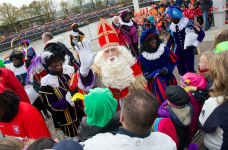‘Black Pete’ Christmas Tradition Is Dividing the Netherlands

The Netherlands has a tradition of white people dressing up in ‘blackface’ to celebrate Christmas. Black Pete is the character they’re portraying. His costume may also comprise exaggerated red lips, a curly afro wig, and huge gold earrings.
At celebrations, Black Pete accompanies Santa Claus, as his bumbling helper.
Known locally as Zwarte Piet, Black Pete is slowly being phased out in some Dutch cities. But, the majority of the country continues on with the tradition. And while Dutch people of colour are sick of the overt racism, white nationalists are now feeling threatened.
Defending prejudice
On November 18, three busloads of Black Pete protesters were stopped on a highway by a group of right-wing nationalists blocking the road. The demonstrators were on their way to the town of Dokkum to protest the Santa Claus arrival ceremony, which features the racist figure.
The police arrived 15 minutes into the standoff. However, the protesters reported that officers spent the next half hour chatting with the nationalists. By the time the demonstrators arrived in the city, they were told it was too late to hold their council-sanctioned protest, as it was a safety issue.
A week later, ten members of the Pro Black Pete Action Group stormed a primary school in the city of Utrecht. Dressed as Black Pete, the members of the group entered classrooms handing out stickers and flyers.
The group had targeted the school as it had ceased including Black Pete in its Christmas celebrations in 2015. When teachers asked the intruders to leave the premises, they responded by telling some of the members of staff to go back to their own country.
Burqa ban violation
And an Amsterdam council meeting was suspended on November 30, when three members of the action group appeared dressed as Black Pete in the back of the gallery. In Amsterdam, the character of Black Pete was completely removed from the city’s official Christmas celebrations last year.
The men were subsequently removed from the building as they were found to be violating a ban on wearing face coverings in government buildings. The 2016 face covering law was enacted with the aim of preventing women from wearing the burqa and niqab in certain public places.
Rooted in slavery
The idea that Santa, or Sinterklaas, has a disquieting helper goes back centuries in the Netherlands. However, modern Black Pete was popularised in a mid-19th century book, “Saint Nicolas and His Servant.” The book depicts Santa Claus as coming from Spain, with his servant, who is a Moor.
Black Pete’s current characteristics began in the 1920s when it was popular for white actors to appear in blackface in films. And his clothes are based upon a mid-17th century practice of wealthy people in Amsterdam, who would dress up an African child in an outfit and give them as gifts.
The Netherlands was heavily involved in the transatlantic slave trade. And the nation grew rich selling enslaved peoples in the Americas or sending them to their own colonies.
The nation signed an international agreement to halt slave trading in 1814. And, it was one of the last countries in the world to abolish the practice of slavery in 1863.
Black Pete is racism
But, over the last decade, a movement against this remanent of slavery has come to the fore. In 2011, Dutch-Antillean activist Quinsy Gario was beaten and arrested on an Amsterdam street for wearing a shirt that read, “Zwarte Piet Is Racism.”
Mr Gario was one of the instigators of the Black Pete is Racism campaign. He began speaking out against the tradition, and appeared on national television denouncing the practice.
The Kick Out Zwarte Piet (KOZP) coalition formed. In November 2015, it began peaceful protests at national Christmas parades. And these resulted in a social media backlash of threats of bodily harm and even death.
In 2016, Dutch children’s ombudsman Margrite Kalverboer released a report outlining that Black Pete contravened the UN Convention on the Rights of the Child. Ms Kalverboer subsequently had to notify Netherlands police about the number of threats to her life that had been made.
UN condemnation
On August 28 2015, the UN Committee on the Elimination of Racial Discrimination released a report on the Netherlands. The committee urged the nation to get rid of Black Pete, stating that “even a deeply-rooted cultural tradition does not justify discriminatory practices and stereotypes.”
The report outlined that “the character of Black Pete is sometimes portrayed in a manner that reflects negative stereotypes of people of African descent and is experienced by many people of African descent as a vestige of slavery.”
The committee raised concerns over reports that citizens who’d sought to conduct peaceful protests against portrayals of Black Pete had been denied authorisation to do so, and had also “been subjected to violent attacks and other forms of intimidation.”
In denial
The Amsterdam Christmas organising committee announced in November last year that Black Pete would be completely abolished from the city’s festive celebrations. This was to move with the changing population, of which 45 percent are from non-western European backgrounds.
In Rotterdam, Black Pete is being gradually phased out of official parades as of this year. Over concerns the changes may disturb children, the city will begin by halving the amount of people dressed as Black Pete this year, followed by 75 percent less next year, and 90 percent less in 2019.
As Black Pete is gradually removed from celebrations, he’s being replaced by a character called Chimney Pete. This helper dresses in the garb of Spanish nobility, and his face is smeared with soot, because he follows Santa down the chimney.
So, it seems that while the majority of municipalities in the Netherlands are continuing on with their blackface tradition, despite the offence it causes people of African descent, the more progressive cities are starting a new tradition of partial blackface.
And when a “deeply-rooted cultural tradition” is still so obviously being referenced, it hardly seems that the practice has been brought to an end or even properly acknowledged as being racist.








